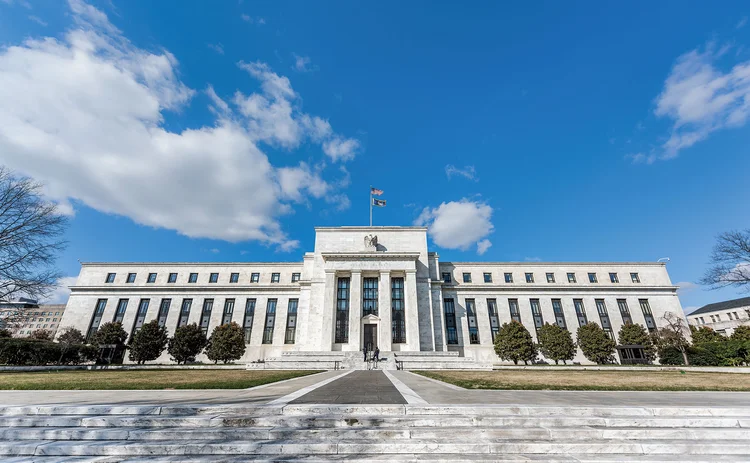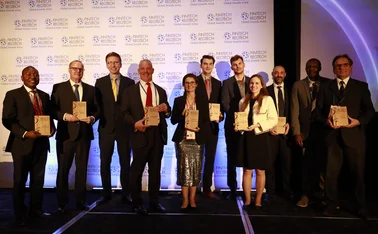
Central bank of the year: The Federal Reserve System
Overwhelming Fed interventions forestalled a damaging global financial crisis

Lockdowns and other measures undertaken to contain the Covid-19 pandemic in 2020 sparked the worst economic crisis since the Great Depression, according to International Monetary Fund chief Kristalina Georgieva. It is hard to imagine, given the human suffering and economic fallout, but the situation could have been even worse, had a crisis taken hold in financial markets, as seemed likely in March 2020.
That financial markets did not completely break down was primarily due to the actions of one central bank, the US Federal Reserve. Under the stewardship of its chairman, Jerome Powell, the Fed acted rapidly and boldly to avert a meltdown – not just in the US, but in markets across the world. The Fed pulled out all the stops in its efforts to shore up US dollar liquidity. And it did so extraordinarily quickly.
Almost a year ago, the onset of the coronavirus pandemic sparked pandemonium in financial markets, as counterparties raced to de-risk their positions. Many market practitioners were forced to sell any assets they could to meet funding needs. While non-banks struggled to raise cash to meet margin calls on derivatives positions, leveraged investors withdrew from government bond markets and major dealers stepped back from repo markets. The term commercial paper market froze, and selling pressure in bond markets, including in ‘risk-free’ US Treasuries, became acute.

The selloff, like the virus, was contagious – as one market after another struggled to function. Peak to trough, the Standard & Poor’s 500 index fell 35%, while median corporate bond spreads in the US widened to 450 basis points, as hundreds of billions of dollars were rapidly withdrawn, amid widespread redemptions from money market funds and a major pullback from emerging-market and high-yield investment funds.
The Fed acted as first responder to address the problem on March 3, by slashing interest rates, following an emergency videoconference meeting that started on the proceeding evening. The Fed’s move prompted other central banks to follow suit. But rate cuts alone would not solve the liquidity squeezes across asset classes and jurisdictions. To restore financial market function, the US central bank had to introduce a raft of emergency liquidity programmes – new programmes, as well as those used in the global financial crisis – on an unprecedented scale. “We are going to use our tools – all of our tools, in a strong way – to try to support the economy,” Powell said on March 3. And so it did.
In little over two months, the Fed had committed $31 billion in average daily discount window demand, $2.5 trillion cumulative to repo lending and $2.2 trillion in asset purchases.
It has also committed $2.7 trillion – although most of it was not used – to eight facilities (its Commercial Paper Funding Facility, Term Asset-Backed Securities Loan Facility, Primary Market Corporate Credit Facility, Municipal Liquidity Facility, Money Market Mutual Fund Liquidity Facility, Main Street Business Lending Program, Secondary Market Corporate Credit Facility and Paycheck Protection Program Liquidity Facility), excluding backstop liquidity from its Primary Dealer Credit Facility. Fed buying programmes extended to corporate bonds, junk bonds, emerging market bonds and exchange-traded funds for the first time.
On the macro-prudential level, the Fed released up to $250 billion in supplementary leverage ratio adjustments, strongly advised banks to restrict dividend payments, and rapidly changed its stress tests of major US banks to assess how secure they were against the risks posed by the Covid-19 pandemic.
“The Federal Reserve took rapid and decisive actions in response to Covid-19, including deploying innovative programmes to keep credit flowing and to support international dollar funding markets,” the IMF's Georgieva tells Central Banking. “Jerome Powell and the Federal Reserve System deserve credit for their agile and creative efforts to support global financial stability in the face of severe stresses – helping to avert a financial crisis that could have morphed into another Great Depression.”
The Fed’s communication remained tightly focused on its role to keep credit flowing to households and businesses. “Chairman Powell’s leadership has been exemplary, both internally with regard to maintaining consensus within the Federal Open Market Committee, and as a credible public spokesperson,” says Gary Stern, former president of the Federal Reserve Bank of Minneapolis.

While the Fed did not safeguard the US economy on its own – it worked closely with the US Treasury and Congress also passed a major fiscal stimulus package early in the crisis – its actions were critical in preventing a financial market meltdown. Ultimately, its unprecedented interventions restored market calm, something that even senior Fed officials appeared unsure would necessarily turn out to be the case. “For a while in the spring [of 2020], the outcome was – as the Duke of Wellington said of Waterloo – ‘a damn, close-run thing’,” said Randal Quarles, Fed vice-chair for supervision.
The Fed demonstrated it had learned lessons from the global financial crisis. This time around, it quickly deployed overwhelming firepower to restore some semblance of normality to markets. The US central bank erred on the larger side, adopting the philosophy that it is easier to scale back, rather than to scale up once a run problem has become larger still.
“They built off the 2008–09 experience, but extended it where they thought necessary. Critically, the goals were met. Markets settled down and credit continued to flow so the financial system did not make a bad situation worse,” Donald Kohn, vice-chairman of the Fed during the global financial crisis, tells Central Banking. “We certainly didn’t get every call right in 2008–09, but the 2020 Fed took to heart Bernanke’s injunction then to keep trying until you figure out what will work.”
There were problems this time around too. Some Fed programmes worked better than others. And US community leaders have criticised the programmes for their seeming to offer more support to large businesses than to smaller enterprises and employees. Some of these criticisms may be valid, but the Fed-administered programmes were created in difficult circumstances, under considerable time pressure. The federal administration, especially the Treasury and Congress, also had major responsibilities for ensuring that aid programmes were effective.
International support
The Fed’s actions were not just relevant for the US. Powell was said to be highly aware of problems in offshore US dollar funding markets in March and early April – and, again, the Fed took decisive action that assisted distressed financial markets.
The US central bank, which already had bilateral dollar swap lines with the central banks of the eurozone, Japan, the UK, Canada and Switzerland, lowered the rates charged on these facilities. It also rapidly expanded the number of bilateral dollar swap lines, signing agreements with the central banks of Australia, Brazil, Denmark, South Korea, Mexico, Norway, New Zealand, Singapore and Sweden. Swap drawings peaked at just under $450 billion. The Fed also set up a temporary repo facility for foreign and international monetary authorities – an important move that bolstered confidence and eased selling pressure in the Treasuries market.
As in the US, these efforts worked. From Brazil to Indonesia and Australia to Mexico, the signs of crisis eased, even though the global economic outlook was grim.
Trusted to do what is needed
The Fed’s actions to calm international markets took place in an ‘America-first’ atmosphere that prevailed in some quarters of Washington, DC, in 2020. Fed president Powell, whose policies during China-US trade negotiations had come under fierce attack from then-US president Donald Trump, was potentially exposed when the Fed provided dollar liquidity to foreign countries. But the Fed did act, and world financial markets did not suffer the crisis that they might have done. The Fed underpinned the dominance of the US dollar for international transactions.
Indeed, throughout the crisis, the Fed succeeded in taking radical steps without arousing significant political opposition – again, something that was far from a given outcome. One factor in its favour was the trust that the Fed has accumulated over the years. Another key element appears to have been the shrewd cultivation by Fed president Powell and members of the Federal Open Market Committee of leading lawmakers and Treasury officials.
This investment proved to be a wise one. Political friction could have delayed some of the Fed’s moves at the beginning of the crisis, leading to a damaging loss of market confidence. Instead, American political leaders of both parties trusted that the Fed was acting in the national interest. That was true even when it did things to which some political partisans might have strongly objected.
Strategic policy review
The Fed also undertook several other significant steps during 2020, including efforts to introduce instant payments, joining the Network for Greening the Financial System and in-depth research into the future workings of a ‘digital dollar’ – to name but a few. But, perhaps the most significant for the near term was its decision on August 27 to become the first central bank to adopt an ‘average inflation targeting’ (AIT) monetary policy regime.
Under this framework, the Fed states that, “following periods when inflation has been running persistently below 2%, appropriate monetary policy will likely aim to achieve inflation moderately above 2% for some time”. The approach aims to boost inflation expectations and prevent them from drifting lower over time. The Fed has also stated it would emphasise maximum employment as a “broad-based and inclusive goal”. As a result, the US central bank is expected to react to unemployment levels that are above estimates of the natural rate of unemployment and not below.
The Fed’s shift to average inflation targeting has prompted other central banks to reflect on the appropriateness of their own monetary policy regimes when interest rates are close to their lower bound. The European Central Bank is considering the adoption of AIT as part of its own strategic review, and other central banks are watching the Fed and thinking carefully about whether they should do likewise.
That is not to say the new approach is not without its critics. There are technical concerns, such as the Fed having provided few details on how it would measure undershooting, the length of time it would tolerate overshooting, and if there is an upper rate of inflation that would trigger a pause or reversal in policy. A wider issue is that the Fed risks undoing years of low and stable inflation, particularly given the size of president Joe Biden’s large Covid-19 fiscal programme, with more fiscal stimulus in the works. There are also fears that the change in stance on unemployment risks further politicising the Fed.
While it is too early to determine if the Fed’s move to AIT will prove successful or turn out to have unanticipated negative consequences – especially if there is a major ‘demographic reversal’, sparking inflation – the move followed an extensive public engagement campaign. The Fed hosted 14 public ‘Fed Listens’ events and engaged extensively with members of the public, as well as with business and community leaders.
Many US institutions have been criticised in recent years by politicians, traditional media and social media for their apparent remoteness. Trump strongly criticised the Fed in his successful 2016 presidential campaign. Yet the Fed has sought to engage with the public, rather than act defensively or hope that the criticism would pass. It is not pretending that it can do nothing and remain trusted. It has also committed to conduct a review of its monetary policy strategy, tools and communication practices “roughly every five years”.
“They deserve kudos for the way they carried out the review with the Fed Listens sessions. It was very transparent, and involved consulting with real people as well as academics, and utilising the regional reserve bank system to good advantage,” says Kohn.
Moral hazard
The Fed’s crisis actions do raise many concerns that will be important to work through in the months and years ahead. There are broad concerns that low interest rates are less effective at supporting credit growth than expected – with many bigger corporations using the cheap funding to conduct share buybacks, rather than make productive capital investments. Governments are unlikely to shy away from borrowing, and conservative investors are being forced into longer maturities and higher-risk assets, leaving them exposed to sudden reversals. Cheap funding is also facilitating leveraged trade positions by non-bank financial institutions, often in the knowledge that the Fed will step in to support ‘liquidity’ in the event of a sharp reversal.
Indeed, moral hazard linked to the Fed supporting asset prices only seems to have grown since its interventions dating back to Black Monday. In the past year, the Fed has also departed from Basel III rules, and it remains to be seen if this move is temporary.
The Fed will need to work out how to extricate itself from these positions in the future, likely via a combination of market reform supported by sustained economic growth. Its path may not prove to be easy.
These concerns are highly valid. But it is also important to reflect on what might have happened had the Fed delayed its actions or made its crisis responses smaller. A massive shock to market confidence was possible, and it seems extremely likely that there would have been a series of large-scale crises in international financial markets. As Stern says: “The key to dealing with moral hazard is preparation rather than ‘throwing the baby out with the bath water’ in the midst of a crisis.” Such a move would likely have greatly deepened the damage to the US and international economy. Instead, the Fed acted as the world’s guarantor of financial market stability. Financial markets calmed down even as the US was gripped by a serious health crisis.
The Central Banking Awards were written by Christopher Jeffery, Daniel Hinge, Dan Hardie, Rachael King, Victor Mendez-Barreira, William Towning and Alice Shen
Only users who have a paid subscription or are part of a corporate subscription are able to print or copy content.
To access these options, along with all other subscription benefits, please contact info@centralbanking.com or view our subscription options here: http://subscriptions.centralbanking.com/subscribe
You are currently unable to print this content. Please contact info@centralbanking.com to find out more.
You are currently unable to copy this content. Please contact info@centralbanking.com to find out more.
Copyright Infopro Digital Limited. All rights reserved.
As outlined in our terms and conditions, https://www.infopro-digital.com/terms-and-conditions/subscriptions/ (point 2.4), printing is limited to a single copy.
If you would like to purchase additional rights please email info@centralbanking.com
Copyright Infopro Digital Limited. All rights reserved.
You may share this content using our article tools. As outlined in our terms and conditions, https://www.infopro-digital.com/terms-and-conditions/subscriptions/ (clause 2.4), an Authorised User may only make one copy of the materials for their own personal use. You must also comply with the restrictions in clause 2.5.
If you would like to purchase additional rights please email info@centralbanking.com






